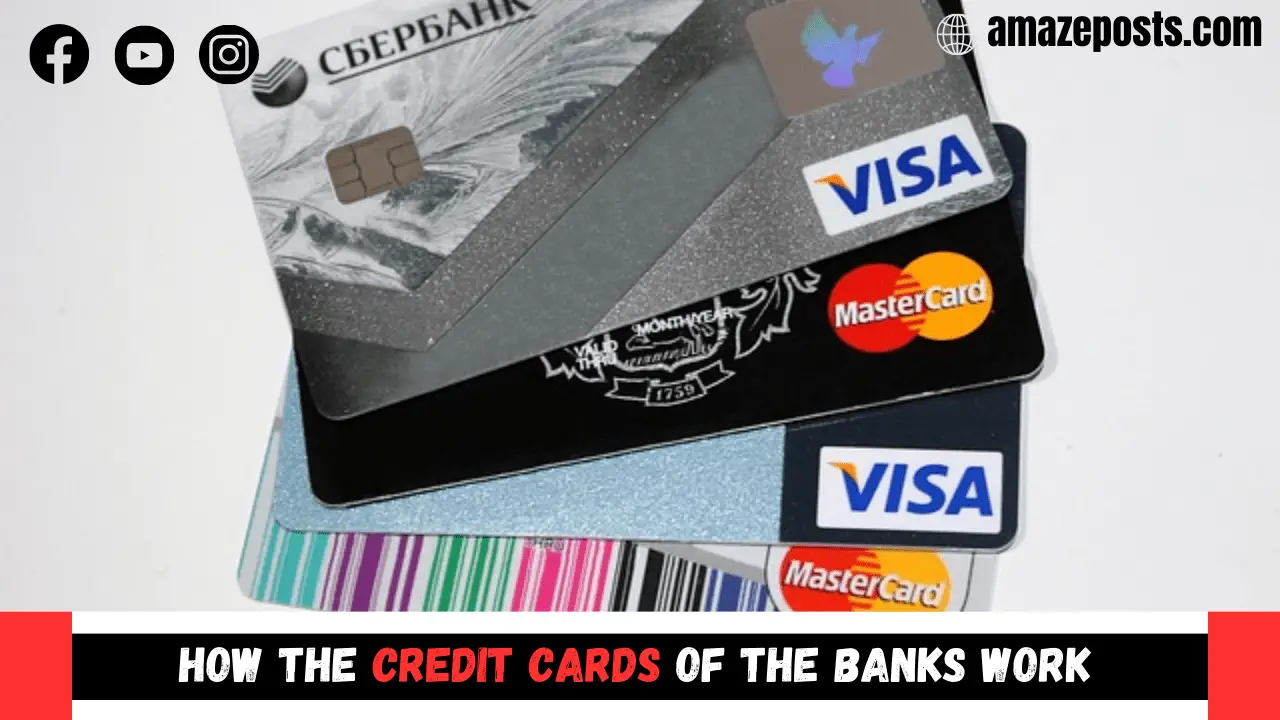Preface
Confused by the connection between credit cards and banks? Bemused no more! In This blog post, we will tell you How the Credit Cards of the Banks work. From comprehending the parties involved to decoding payment procedures and safety protocols, get ready for an enlightening voyage into the world of credit cards and banking. You’ll be armed with the info you need to navigate this complex monetary system like a pro!
Credit cards: what are they?
The cardholder can use a credit line to make purchases or get a cash advance with the card. Typically printed on PVC or paper composite, they have a magnetic stripe or chip that can be read by electronic readers.
It is common for credit cards to have a grace period of 20-30 days during which the cardholder can pay off the balance in full without incurring interest charges. A credit card will charge interest from the date of purchase (or cash advance) if the balance is not paid in full. In addition to late payments, annual membership fees, and cash advances, credit cards typically charge fees for late payments, as well.
How do the Credit Cards of the Banks work?
This article examines how credit cards work and how banks make money from issuing them. These cards are one of the most popular methods of payment today.
When you use a credit card to make a purchase, the credit card company pays the merchant for the amount of your purchase. If you do not pay your balance in full each month, you owe the credit card company the amount of money, plus interest and fees. The annual percentage rate (APR) is the interest rate charged by the credit card company.
Every month, the bank that issued your credit card will send you a statement that details your purchases, payments, and any interest or fees you have incurred. You can choose to pay off your entire balance or just make a minimum payment. The remaining balance will be subject to interest if you only make the minimum payment.
Additionally, most credit cards offer rewards programs that allow you to earn points or cash back on your purchases. These rewards can be redeemed for cash or gift cards.
As well as charging merchants fees to process credit card payments, banks that issue credit cards also earn money by charging interest and fees on late payments or balance transfers. As a result of receiving a fee from the partner companies that offer rewards, banks also earn money from the rewards they offer.
you can know more about banking by clicking on the > Banking explained.
Bank credit cards types
Banks offer four types of credit cards: prepaid, secured, unsecured, and business.
In order to use prepaid cards, funds must be added to the card and they can be used anywhere that accepts credit cards. Prepaid cards are not linked to a bank account, so there is no credit limit.
If you have bad credit or no credit history, secured cards can help you rebuild your credit. These cards are usually backed by a deposit made with the issuing bank.
Unsecured cards do not require a security deposit and typically have higher interest rates and annual fees than secured cards.
In addition to cash back on business expenses, reward points, and 0% interest periods, business credit cards are designed for business owners. Business owners can manage their finances more effectively with these cards because they often have higher credit limits than personal cards.
Credit Cards Have Many Benefits
While credit cards have many benefits, such as the ability to make purchases without carrying cash, the ability to build a credit history, and the potential to earn rewards, it’s important to understand how they work.
When you use a credit card, you are borrowing money from the card issuer. If you don’t pay your balance in full each month, you will have to repay this debt, plus interest and fees. If you’re able to do this, you can use your credit card responsibly and enjoy its benefits. Keep an eye on your spending and make your payments on time to prevent damage to your credit.
Having a credit card can also help you build a good credit history, which is important for getting approved for loans and other financial products. The credit score of your credit card will improve as you make timely payments, and many cards offer rewards like cash back or travel miles that can be redeemed for discounts or free travel.
It is important to understand how credit cards work and shop around to find the best option for you if you use them wisely and keep your balance low.
Credit Cards: Advantages and Disadvantages
Using credit cards has advantages and disadvantages. Some of the advantages include the ability to build credit, the convenience of not carrying cash, and the rewards that many cards offer. High-interest rates, fees, and the temptation to overspend are some of the disadvantages.
When used responsibly, credit cards can be a great tool. They can help you build your credit history and improve your credit score. Additionally, they are convenient and secure. You don’t need to carry around cash, and if your card is lost or stolen, you can cancel it and get a replacement.
If you don’t pay your bill in full each month, you will be charged interest on the outstanding balance. The biggest downside to using credit cards is the potential to incur debt. It’s also important to read the fine print on a credit card agreement before signing up because credit card companies usually charge annual fees, late payment fees, and other charges that can add up quickly. These all are also included in that how the Credit Cards of the Banks work.
Before using a credit card, weigh the pros and cons carefully. If used responsibly, they can be an invaluable financial tool. But if you’re not careful, they can lead to debt and financial stress.
Credit Card Interest Rates: An Overview
There are so many different types of credit cards out there, each with its own interest rate. It can be difficult to keep track of all the different rates and how they work. It is our goal in this article to provide you with a complete understanding of credit card interest rates.
Among the first things you’ll notice when shopping for a credit card is the APR, or annual percentage rate. If you do not pay off your balance in full every month, you will be charged an interest rate on your balance. An APR can differ greatly from one credit card to another. For example, some cards may have 0% interest rates while others may have 30% interest rates.

A second thing to note about credit card interest rates is that they are usually variable. Depending on market conditions, the interest rate can fluctuate over time. For example, if the prime rate goes up, your credit card’s APR will likely go up as well. Nevertheless, not every credit card offers a variable interest rate. A fixed rate is a rate that will never change over the life of the card. These all are also included in that how the Credit Cards of the Banks work.
In order to avoid being charged late fees, you need to make the minimum payment on your credit card each month. Your minimum payment will typically be around 3-5% of your total balance due.
Credit Card Debt Management Tips
Most people have at least one credit card. If you’re like most people, you probably have some debt on that credit card. However, there are ways to manage your credit card debt so that it does not take over your life. Credit card debt can be a great burden, both financially and emotionally.
You can manage your credit card debt by following these tips:
1. Know how much you owe. This may seem obvious, but many people don’t actually know how much they owe on their credit cards. It is impossible to make a plan to pay off your debt if you do not know how much you owe. You should start by adding up all the debts you owe on your credit cards.
2. Create a budget. After you know how much you owe, you need to make a budget. You need to figure out how much money you have coming in each month and how much money you can put toward your credit card debt realistically. If you want to avoid running out of cash each month, you should include other expenses as well in your budget.
3. When you have a budget in place, it is time to create a credit card payment plan. If you make more than the minimum payment each month, you will be able to pay off your debt sooner rather than later. It is also a good idea to prioritize the debts with the highest interest rates so that you can save money in the long run.
4. Consider a balance transfer. If your credit card has a high-interest rate, you might want to consider transferring your balance to one that has a lower interest rate. This can help you save money. Before making any decisions, make sure you take into account all of the fees associated with the balance transfer.
5. You should reach out to your creditors as soon as possible if you are unable to make payments on time or in full each month. You may be able to avoid late fees or other penalties by being proactive and communicating openly with your creditors. They may be willing to work with you and create a payment plan that works for both of you.
With some patience and dedication, you’ll be able to get back on track financially and put your credit card debt behind you once and for all.
Credit Card Alternatives
There are several alternatives to using a credit card. Debit cards draw their money from your bank account, providing security against going into debt. For those who have difficulty controlling their spending, cash is another option. Prepaid cards can also be beneficial as they allow you to pre-load them with a certain amount of funds, thus limiting the rate at which you spend.
Furthermore, some banks offer services such as online money transfers or check cashing. These can be convenient ways to make purchases without using a credit card.
In conclusion
We hope this overview of how credit cards work has proven beneficial in comprehending the system. Breaking down its components can simplify it, arming you with the knowledge to make responsible decisions regarding your finances and credit utilization. Be sure to carefully read through all terms and conditions of any card before applying for it so as to maximize rewards prospects while avoiding potential risks.
